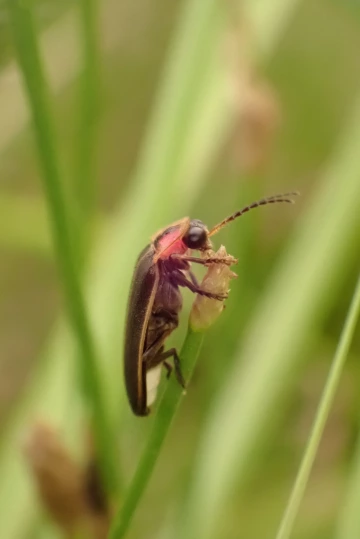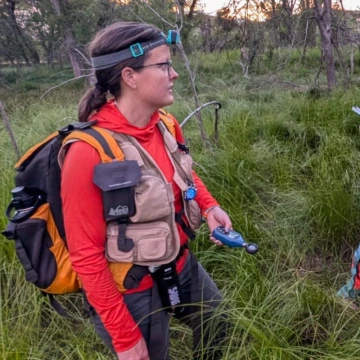Finding fireflies in the desert: Researcher sheds light on one of Arizona's least-known insect species
Rachel Laura, a doctoral student in the School of Natural Resources and the Environment, is answering fundamental questions about the southwest spring firefly.

Julius Schlosburg

The southwest spring firefly (Bicellonycha wickershamorum)
Candace Fallon, The Xerces Society
Summertime in Tucson means the arrival of scorching temperatures, spectacular monsoon storms – and fireflies.
Though it may come as a surprise, Arizona is home to around two dozen firefly species. According to Rachel Laura, a doctoral student in the School of Natural Resources and the Environment, there are good reasons why you may not have known about these glowing natives.
To begin with, many of Arizona’s firefly species don’t behave like their popular Midwestern cousins, who appear at twilight, take flight and flash to attract a mate.
“There are dark fireflies, for example,” she said. “They come out during the day and don’t glow, but their eggs and larvae do. And there are glow worm fireflies, where the females glow from the ground to attract non-glowing males.”
Some of Arizona’s fireflies do put on the trademark nighttime display, though – and two of them live near Tucson. The southwest spring firefly usually appears near rivers and streams in June and early July. Once the monsoons arrive, the southwest synchronous firefly takes over, flickering in open, grassy areas along streams.
Another reason for the fireflies’ obscurity is that we just don’t know very much about them. Laura says that when she first became interested in southwest spring fireflies in 2023, there was only one scientific paper that described the species, and only 26 recorded sightings.
Laura says that studying these insects makes her feel a bit like a nineteenth century naturalist. “It feels like going back in time, when people were exploring the world and describing all these new species,” she said. “There are so many fundamental questions we don’t have answers to: How many are there? Where do they live? What are their habitat needs?”
Filling in the gaps – in knowledge and in methods
Laura set about answering some of these questions by conducting field surveys beginning in 2024.
The first set of surveys took place near Patagonia, Arizona, and focused on collecting basic data about population, habitat, dispersal patterns and behavior. This summer, she plans to return to the same site to build on what she learned and get more information about specific habitat requirements – whether there’s a specific soil type or vegetation condition they need, for example. In the final summer of her project, she’ll focus her surveys in Central Arizona to gather data on populations there.

Rachel Laura prepares for an evening of surveying fireflies.
Candace Fallon, The Xerces Society
“That first summer was more of a pilot study,” she said. “I wanted to try out a couple of different techniques for estimating population size, since there hasn’t been a good method established for sampling fireflies.”
Laura explained that getting an accurate count of any species is a challenge wildlife biologists know well.
“When you’re counting anything in nature – whether it’s birds or lizards or flowers - you know you’re not detecting everything that’s out there,” she said. “Wildlife biologists use different methods to account for that.”
For her firefly surveys, Laura adapted a sampling method commonly used in birds: distance sampling. For that method, it’s essential to measure the distance between the scientist and each firefly they see. She used a night vision range finder to measure the distance between a herself and every firefly she spotted within a minute, calling out distances to volunteer data recorders.
“It sounds like a crazy idea,” she said. “But I got pretty lucky in that the species I’m studying has a lot of traits that make it easier for it to work. It’s in low densities, so you’re not seeing hundreds at a time – it’s closer to seven or ten in the span of a minute.”
Laura and her team repeated the process every minute in five-minute stretches, paying close attention to where each flash occurred in order to avoid double-counting.
“I’m still analyzing the data we got last summer,” she said. “From what I’ve seen so far, it’s very promising that this method will work and result in accurate estimates.”
Calling all citizen scientists
Laura’s project aims to assess the southwest spring firefly’s habitat needs, determine its distribution in Arizona, and to figure out whether it's at risk of extinction. But she isn’t the only scientist investigating Arizona’s fireflies.
“The Xerces Society has a program called the Firefly Atlas, which is a community science platform that recruits and trains people to go out on their own and sample for fireflies,” she said. “Last year they had over 250 participants across the country, and the southwest spring firefly was the one most surveyed.”
She encourages anyone who’s interested to consider submitting their own firefly encounters.
“You don’t have to go way out into the back country to find them, either,” Laura said. “There are even fireflies in Tucson along the Santa Cruz. Any areas with perennial water are great places to look. If you keep an eye out for them, and you’re patient, and you’re a little bit lucky, they’re out there.”
